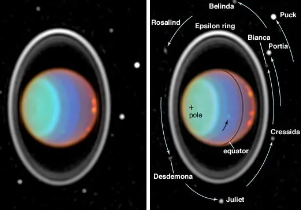Uranus: New Insights Into Its Mystifying Magnetic Field
Recent studies have revitalized interest in Uranus, the ice giant visited by Voyager 2 in 1986. New analyses of Voyager 2’s data reveal complexities in Uranus’s magnetic field. These findings challenge previous assumptions about the planet’s magnetosphere. They may also reshape our understanding of other gas giants.
Voyager 2’s Historic Encounter
Voyager 2 provided the first close-up images of Uranus. It discovered unexpected features, including intense radiation belts. The spacecraft recorded a plasma-depleted magnetosphere, leading to questions about planetary magnetic fields. Uranus was seen as an anomaly among gas giants.
Reanalysis of Historical Data
A recent study reexamined data from the Voyager 2 mission. Researchers found that a solar wind event occurred just before the spacecraft’s arrival. This event compressed Uranus’s magnetosphere. The timing of Voyager 2’s encounter was crucial, as it happened during a rare condition.
The Role of Solar Wind
The solar wind likely expelled plasma from Uranus’s magnetic bubble. It also intensified the radiation belts by injecting electrons. This dual effect contributed to the unusual observations made by Voyager 2. Such conditions occur only about 4% of the time.
Implications for Uranus’s Moons
The new findings suggest that Uranus’s five major moons may not be geologically inactive. The absence of plasma previously led scientists to believe the moons were dormant. Now, there is speculation that these moons might actively release ions into space.
The National Academies’ 2023 Decadal Survey prioritised Uranus for future exploration. These recent revelations are essential for mission planning. About Uranus’s dynamic magnetosphere will guide future spacecraft design and objectives.
Importance of Revisiting Data
This study puts stress on the value of historical data analysis. New analytical techniques can yield fresh vital information about past missions. Revisiting old datasets can enhance our understanding of planetary science.
Ongoing Exploration of the Solar System
Uranus continues to be a compelling subject for research. The planet holds many mysteries that await discovery. As technology advances, our ability to explore and understand Uranus will improve. Future missions promise to unveil even more surprises.
Important Facts for Exams:
- Voyager 2: Voyager 2 is a NASA spacecraft launched in 1977. It conducted flybys of Jupiter Saturn Uranus and Neptune. It provided invaluable data about our solar system’s outer planets.
- Magnetosphere: The magnetosphere is the region around a planet dominated by its magnetic field. It protects planets from solar wind and cosmic radiation. About magnetospheres is crucial for planetary science.
- Solar Wind: Solar wind is a stream of charged particles released from the sun. It can affect planetary atmospheres and magnetospheres. Its interaction with planets can lead to important changes in their environments.
Month: Current Affairs - November, 2024
Category: Science & Technology Current Affairs


